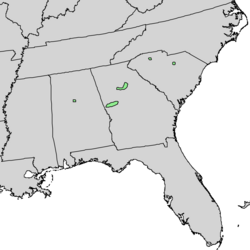| Georgia oak | |
|---|---|
 | |
| Georgia oak leaves | |
| Scientific classification | |
| Kingdom: | Plantae |
| Clade: | Tracheophytes |
| Clade: | Angiosperms |
| Clade: | Eudicots |
| Clade: | Rosids |
| Order: | Fagales |
| Family: | Fagaceae |
| Genus: | Quercus |
| Subgenus: | Quercus subg. Quercus |
| Section: | Quercus sect. Lobatae |
| Species: | Q. georgiana |
| Binomial name | |
| Quercus georgiana | |
 | |
| Natural range | |
Quercus georgiana, the Georgia oak or Stone Mountain oak, is a rare deciduous red oak, native to the southeastern United States.




